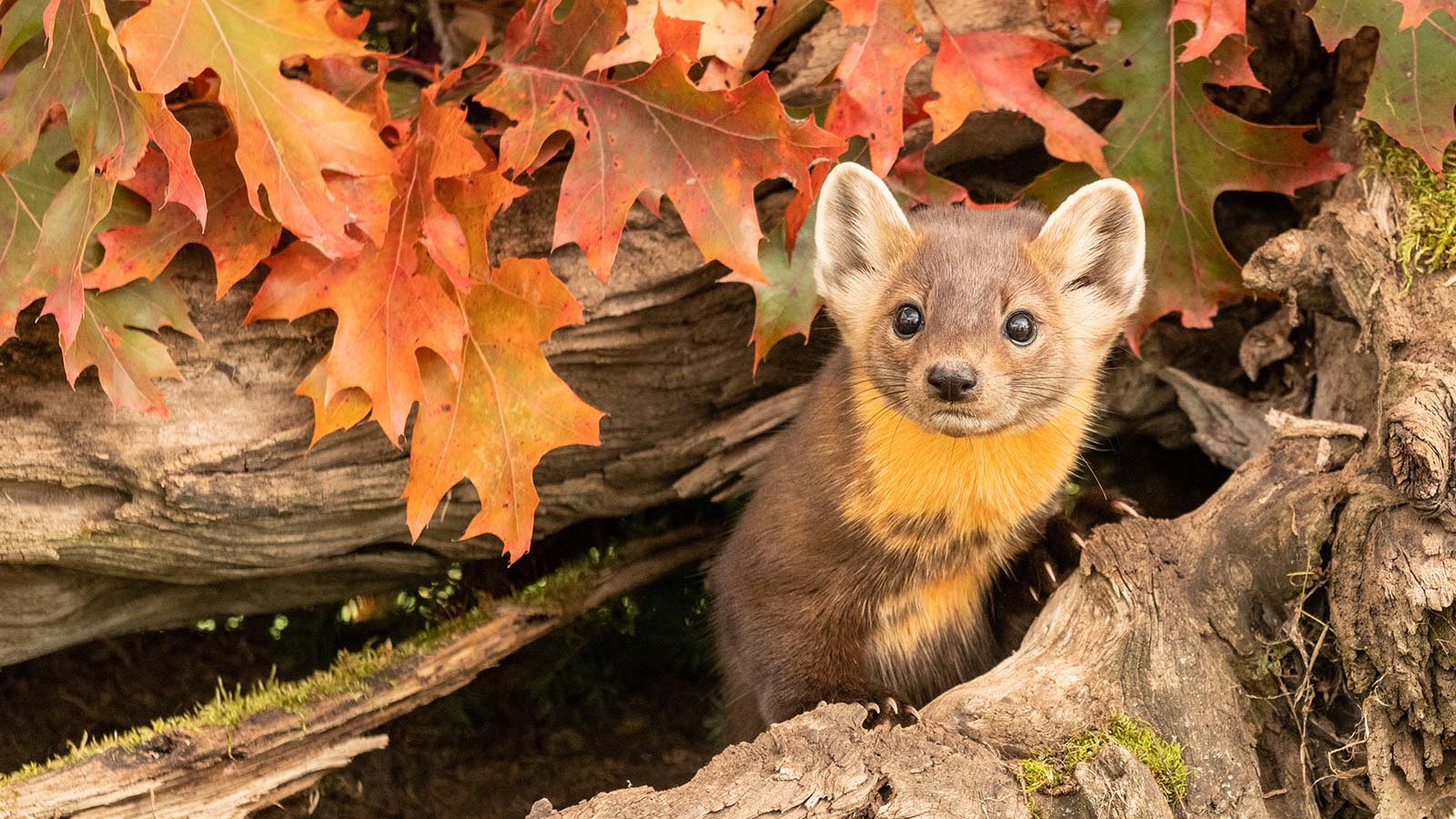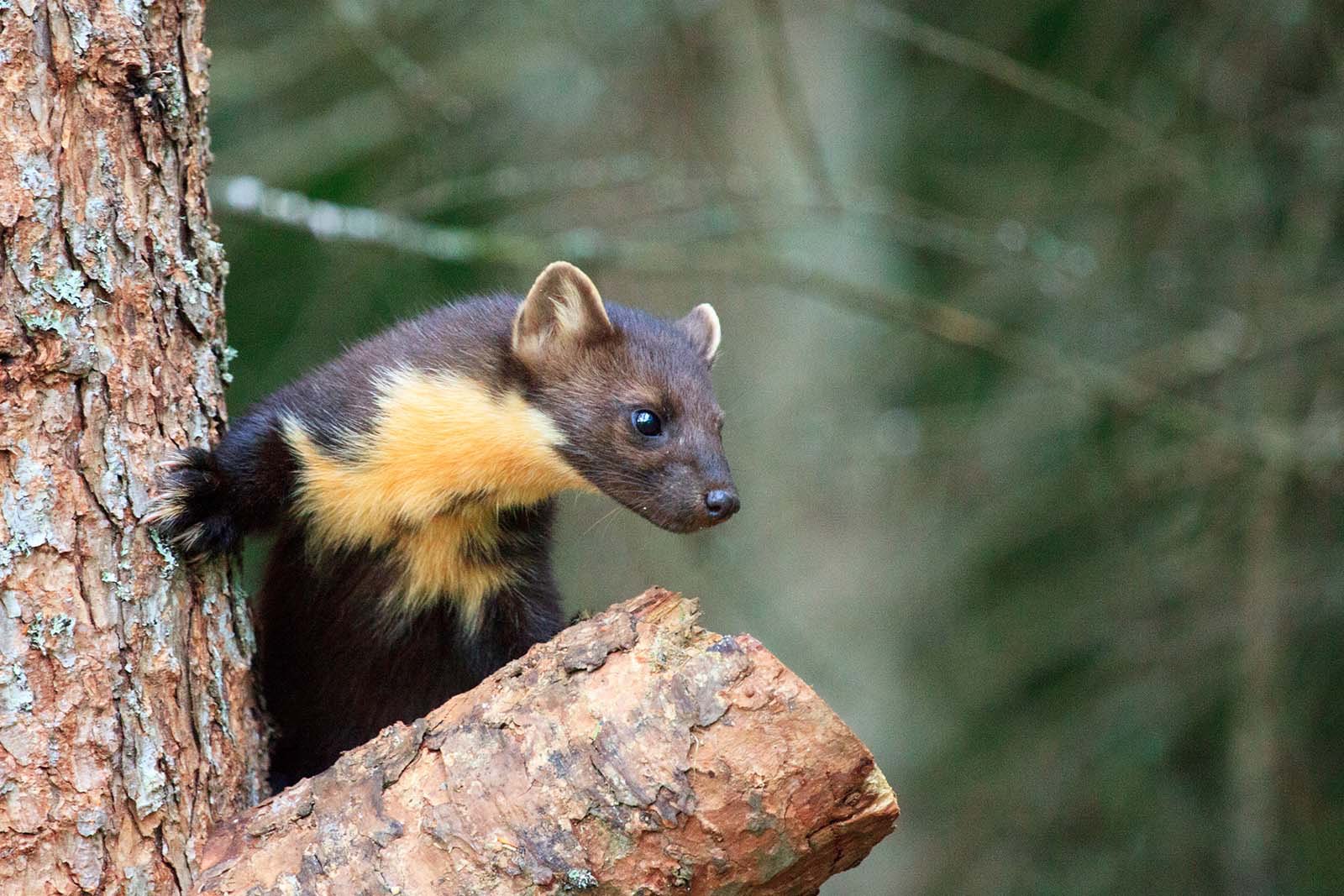- projects
- population reinforcement
- the pine marten recovery project
To further facilitate pine marten recovery (and subsequently aid in red squirrel recovery alongside it) Wild Gaia is proposing to install a number of artificial den boxes across suitable woodland areas in Ireland, in particular where pine marten have already been recorded.


Closely following the methodology successfully used in Scotland by Croose, Birks and Martin (2016), the boxes will be 55 cm (height) by 51 cm (width) by 24 cm (depth). The central chamber will measure 20 cm x 25 cm, with a depth of 50 cm (matching the size of a black woodpecker Dryocopus martius nest chamber, which martens commonly use as den sites in continental Europe). Boxes will also include two internal “chimney” entrances opening into the central chamber to allow multiple entry/exit options for potential escape and to provide ventilation. Boxes will be fitted to trees at approximately 4m in height to limit human/predator disturbance and will face the prevailing wind in order to shelter the entrances against the tree trunk.
The elusive pine marten was once the second most common carnivore in Britain and Ireland. Their past distribution is thought to be linked intrinsically to the history of woodland cover. Considered a woodland specialist, the earliest evidence of pine marten in Ireland dates to 2800 BP. Woodland in Ireland suffered devastating declines in the 16th and 17th centuries to 2% land cover, declining further to 1.5% at the beginning of the 20th century. Today, Ireland’s forest cover stands at 11% total land cover, with the majority consisting of non-native conifer plantations and only 1.2% consisting of native woodland. Total forest cover in Ireland is 20% below the European average.
Recieve detailed updates by joining Wild Gaia
Help support us by sharing the project
Make a direct contribution to the project
The clearance of woodlands, in combination with predator control, had a catastrophic effect on the pine marten population and by 1915 the species was confined to select, remote areas within Britain and Ireland. A survey conducted in the 1970s, found that pine martens were largely restricted to the midwest of Ireland. Subsequent legal protection within Ireland (Irish Wildlife Acts 1976-2012 and Wildlife Order 1985) and at a European level (European Habitats Directive, Annex V) in combination with the banning of strychnine for use as a poison in the 1980s, are all thought to have aided species recovery. Recent, island-wide, surveys have shown that the species is now recovering and is found more widely distributed across Ireland.
Current research following this recovery in numbers, has demonstrated that there are further potential benefits to an increase in pine martens, with their presence appearing to reverse red squirrel replacement by grey squirrels on a regional basis and red squirrel occupancy being positively affected by exposure to pine marten. The non-native, invasive grey squirrel displays exactly the opposite, with a strongly negative response to pine marten presence.
To further facilitate pine marten recovery (and subsequently aid in red squirrel recovery alongside it) Wild Gaia is proposing to install a number of artificial den boxes across suitable woodland areas in Ireland, in particular where pine marten have already been recorded. As a woodland specialist, they favour above-ground, arboreal den sites to rest and breed in. In particular, den sites need to be sheltered and elevated to meet the needs of breeding females and the current scarcity of suitable sites due to a lack of suitable, mature woodland may be a critical constraint upon pine marten populations. As a result of a lack of aboveground den sites, martens may use alternatives, at or below ground-level (i.e burrows, rocks, tree roots, bird boxes or buildings). This can result in an increased predation risk from red fox Vulpes vulpes, or human disturbance, such as exclusion from dens or persecution.
The purpose of installing artificial den boxes for pine martens, therefore, is twofold:
• To increase the availability and diversity of suitable den sites for breeding female martens
• To aid monitoring of the marten population
The den boxes will initially be installed at sites where pine martens have previously been recorded and in stands of long term retention. If successful, further boxes will be installed to link areas of suitable habitat where possible.
Den boxes will be monitored under licence, once per year in May, when breeding females are occupying natal den sites with their dependent kits (born during March and April). Where practical, camera traps will be set up during breeding season to record usage and monitor individuals/breeding success without disturbance.
It is our hope that by increasing viable denning options, pine marten populations will continue to increase and disperse across a greater area within Ireland, leading to increased pressure on grey squirrel populations and by proxy, allowing our native red squirrels a fighting chance to make a population recovery of their own.

catriona porter
Ecologist
Cliodhna Loughran
Research

cormac loughran
Founder

karl hamilton
Raptor Ecologist

philip leathem
Photographer / Videographer
Vwt.org.uk. (2011). Pine marten | The Vincent Wildlife Trust. [online] Available at: https://www.vwt.org.uk/species/pine-marten/.
Creswell, W.J., Uk and Mammal Society (2012). UK BAP mammals : interim guidance for survey methodologies, impact assessment and mitigation. London: Mammal Society.
Croose, E., D.S Birks, J. and Martin, J. (2016). Den Boxes as a Tool for Pine Marten Martes Martes Conservation and Population Monitoring in a Commercial Forest in Scotland. Conservation Evidence Journal, [online] (13), pp.57–61. Available at: https://www.researchgate.net/publication/305692079_Den_boxes_as_a_tool_for_pine_marten_Martes_martes_conservation_and_population_monitoring_in_a_commercial_forest_in_Scotland [Accessed 19 Jan. 2024].
O’Reilly, C., Turner, P., O’Mahony, D.T., Twining, J.P., Tosh, D.G., Smal, C., McAney, K., Powell, C., Power, J. and O’Meara, D.B. (2021). Not out of the woods yet: genetic insights related to the recovery of the pine marten (Martes martes) in Ireland. Biological Journal of the Linnean Society, 132(4), pp.774–788. doi:https://doi.org/10.1093/biolinnean/blaa214.
P. Twining, J. (2020). Declining invasive grey squirrel populations may persist in refugia as native predator recovery reverses squirrel species replacement. Journal of Applied Ecology, [online] 58(2), pp.248–260. Available at: https://besjournals.onlinelibrary.wiley.com/doi/10.1111/1365-2664.13660 [Accessed 19 Jan. 2024].
Join us and become part of a community committed to restoring Ireland’s natural beauty: